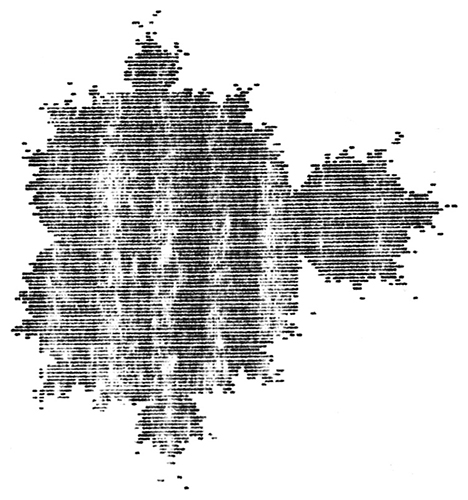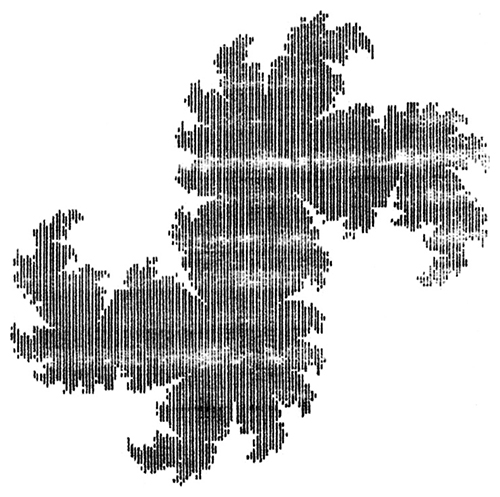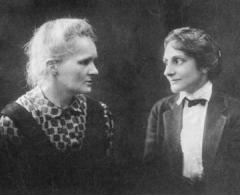
This Article From Issue
January-February 2013
Volume 101, Number 1
Page 60
DOI: 10.1511/2013.100.60
THE FRACTALIST: Memoir of a Scientific Maverick. Benoit B. Mandelbrot. xviii + 324 pp. Pantheon, 2012. $30.
Thirty years ago, when I was new to writing about computation and mathematics, I received a note from Benoit Mandelbrot suggesting we have lunch. I was flattered that the celebrated author of The Fractal Geometry of Nature had noticed my work, and I looked forward to meeting him. When the day came, we had a pleasant meal and a lively conversation. But Mandelbrot had not summoned me merely to eat and chat. He also wanted to lodge a protest: In a recent article I had mentioned the word fractal without also mentioning the name Mandelbrot. I tried to defend myself, pointing out that the word appeared just once, in a passing reference. I noted that I also spoke of gravity without Newton, of geometry without Euclid. But Mandelbrot would have none of this. He looked upon fractal the way Kimberly-Clark looks upon Kleenex—with delight at the term’s popularity, but also with dismay that people forget where it came from.
Mandelbrot never gave up his zealous pursuit of proper recognition. (He died in October 2010.) His memoir, The Fractalist, continues the campaign.
Mandelbrot surely does have claims to fame. Early in his career he did important work on statistical distributions, starting from George Kingsley Zipf’s observations about the frequencies of words in written language. The Zipf distribution has “long tails,” meaning that rare words are not nearly as rare as one might expect. Mandelbrot showed that long-tailed distributions are themselves not nearly as rare as one might expect; they turn up in many other contexts in addition to linguistics. In the 1960s he demonstrated their particular importance in finance.
Another of his contributions concerned dynamical systems, which trace certain kinds of intricate paths through a mathematical space. Two famous artifacts of this work are the Julia set, which Mandelbrot named after the French mathematician Gaston Julia, and the Mandelbrot set, which others named after Mandelbrot.

From The Fractalist.
What about fractals? The word is indisputably Mandelbrot’s invention, but beyond that it gets complicated. Much of the underlying mathematics goes back 100 years or more, including the key idea of fractional dimension—which describes objects so wiggly or crumpled that the measure of their size lies somewhere between a line and a plane, or between a plane and a volume. Mandelbrot’s contribution to the study of fractals was not to prove deep theorems but to pull together many scattered threads and create what he calls “the first-ever theory of roughness.” Then, by force of personality, he persuaded many other mathematicians to pay attention.
Mandelbrot was born in Warsaw in 1924 to a Jewish family with roots farther east. They moved to Paris a few years before the Nazi invasion of Poland, then fled Paris for the marginally safer refuge of Vichy France, which was ruled by mere collaborators rather than occupiers. The family survived on their wits, aided by the kindness of neighbors and anonymous benefactors. Toward the end of the war, Benoit was sent off on his own with forged papers; he wound up working as a horse groom at a chalet in the Loire valley. Mandelbrot describes this harrowing youth with great sangfroid. Eluding the Gestapo is nothing to get emotional about—unlike his later adventures in the academic world.

From The Fractalist.
Back in Paris in 1944, Mandelbrot set about earning the appellation of “maverick” that he accords himself in the subtitle of this volume. He was admitted to the august École Normale Supérieure—one of only 15 students accepted that year. But he quit after one day and defected to the less aristocratic École Polytechnique. As he tells the story, the reason for this abrupt change of plan was a matter of mathematical ideology. Normale was the turf of the group known as Bourbaki, who favored a formal, abstract brand of math; Mandelbrot’s uncle Szolem Mandelbrojt was a founding member. Benoit sought a more freewheeling style. It’s worth noting that the pattern on exhibit here—winning admission to the most exclusive club and then rejecting it—was to become a lifelong habit.
Undergraduate studies at Polytechnique were followed by a sojourn at Caltech. Then Mandelbrot returned to Paris to tidy up loose ends: a military obligation and a Ph.D. Next came a decade of postdocs and other temporary appoints: at MIT, Princeton, back to Paris, Geneva, Paris yet again. Then came “a teaching job with ironclad tenure at the University of Lille.” In this case he didn’t quit after the first day but after the first academic year. He took off for a summer job at IBM Research in Yorktown Heights, New York.
Surprisingly, the summer job turned into a real career. “The golden age of IBM in the sciences coincided with the thirty-five years of my own belated golden period. . . . Having come by chance in 1958, I stayed because nobody offered a better fit, and quickly thrived. The gamble for both parties was very successful.” Nobody offered a better fit, but he never stopped looking for the kind of proper professorship that he felt was his due. Over the years he had tryouts in three departments at Harvard, became an “institute lecturer” at MIT, had an offer from the University of Chicago that fell through, and turned away an inquiry from the Collège de France. Finally he reached an arrangement at Yale that evolved into a Sterling Professorship in 1999, when he was 75.
Mandelbrot begins one chapter of his memoir with the declaration: “A blessing throughout life: I never wonder who I am.” He is untroubled by doubts or regrets, and untainted by false humility. In these pages you will find no self-effacing disclaimers about standing on the shoulders of giants; if Mandelbrot has seen a little farther, it is because he’s taller. From an early age his scientific hero was Johannes Kepler, and his goal in life was to accomplish something worthy of a modern Kepler, overthrowing an outworn orthodoxy. By his own account, he succeeded brilliantly, with quite a number of “Kepler moments.” (As far as I know, Kepler himself had only one.) After describing his youthful work on the Zipf distribution, he remarks, “No one could predict that I was to be called the ‘Kepler of word frequencies,’ then more generally the ‘father of long tails.’” And when he turns again to long tails in a financial context, he contrasts his work with the earlier ideas of Louis Bachelier under the subheading “Kepler Versus Ptolemy.” When I first picked up The Fractalist, I winced at some of this strident puffery, but as I read further, the voice began to grow on me. After all, the genre of this work is memoir; it’s a first-person narrative in which Mandelbrot shows us his world as he sees it. Inevitably he is always in the spotlight at center stage, and everyone else has at best a supporting role.
I can forgive this much egotism. What’s not so endearing is to see some of the supporting actors denied even a listing in the credits. For example, Mandelbrot carried on a bitter public feud with the economist and computer scientist Herbert Simon. For six years they traded critiques and replies, final notes and postscripts to final notes in the pages of Information and Control. The incident is mentioned in The Fractalist, but Simon goes unnamed; Mandelbrot refers to him as “a loud opponent of mine.” It could be worse, I suppose. Instead of ignoring Simon, Mandelbrot might have taken one last swipe at him—a postscript to the postscript.
It’s not just loud opponents who become unmentionable. Adrien Douady and John H. Hubbard made crucial contributions to the understanding of the Mandelbrot set, but they too go unnamed here; this omission is particularly ungracious in that it was Douady and Hubbard who gave the set its name.
Even when Mandelbrot makes an effort to acknowledge others’ work, the gesture somehow gets twisted around and winds up pointing back at Mandelbrot again: “The terms ‘Julia set’ and ‘Lévy process’ drew blank stares when I introduced them,” he writes. “Today, fractalists use them every day. . . . Although some cynics attribute to Julia or Lévy ideas that I originated, I am delighted that this terminology has taken root.”
In spite of all the posturing and defensive maneuvering, Mandelbrot emerges from this story as a surprisingly charming character. I am grateful that he took the time in his last years to set down this testament. Telling the story of one’s own life is a human impulse that is too often suppressed, usually on the grounds that “no one would be interested in little old me.” Mandelbrot had no trouble on that score.
Brian Hayes is Senior Writer for American Scientist. He is the author of Group Theory in the Bedroom, and Other Mathematical Diversions (Hill and Wang, 2008) and Infrastructure: A Field Guide to the Industrial Landscape (W. W. Norton, 2005).

American Scientist Comments and Discussion
To discuss our articles or comment on them, please share them and tag American Scientist on social media platforms. Here are links to our profiles on Twitter, Facebook, and LinkedIn.
If we re-share your post, we will moderate comments/discussion following our comments policy.